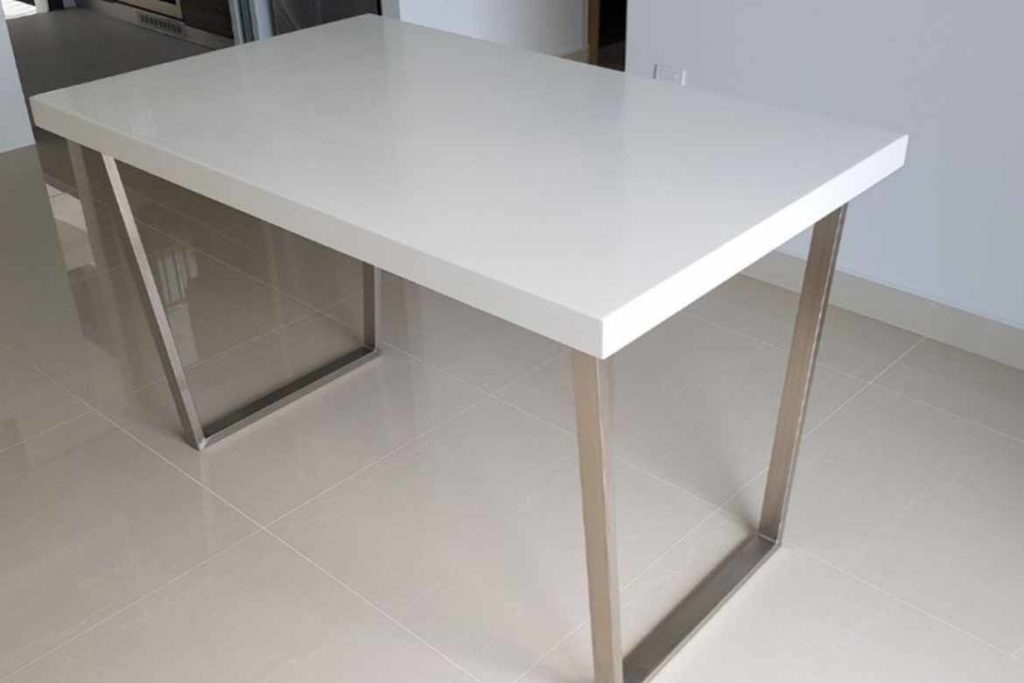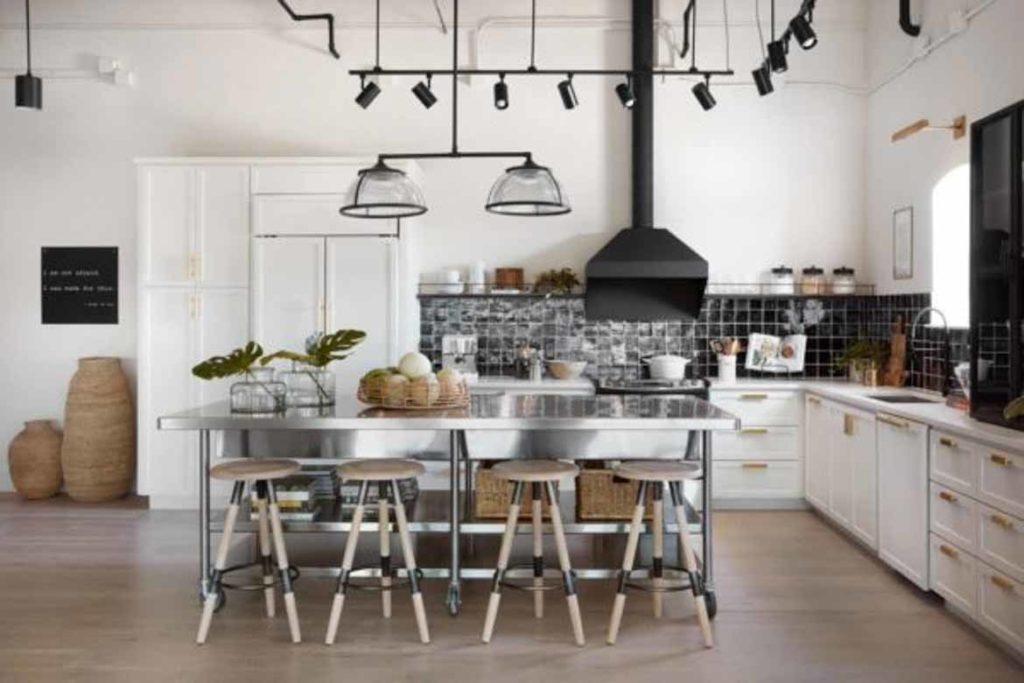What’s best when it comes to dining tables: tradition or innovation?

September 30th, 2022
A good tabletop material should be lightweight, durable, and aesthetically pleasing. The surface of a dining table has to endure a lot over its lifespan, from scratches and nicks to heat and impact. As such, some of the most popular materials for dining tabletops are quartz, granite, wood, marble and glass.
The most common tabletop materials used in Singapore are quartz and solid wood. Solid wood is a traditional dining table material which has been in use for centuries. This is because wood has always been relatively affordable and easy to obtain (particularly in comparison with stone such as marble). Wood is also easier to work with and carve which made it the most convenient tabletop choice over the years.
Currently, wood is still a firm household favourite. Timber tabletops can be found all across the country. This is because wood is a highly versatile material – one can purchase cheap and luxury wood types alike. However, other materials are beginning to find their way into the public consciousness. This is because of technological advancements which are championing easier access to specialized materials. Here is an overview of some of the table top materials contending for a place in Singapore’s homes.

VULCAN by Lian Hin is a range of sintered solid surface slabs composed from clays, feldspars, kaolin and quartz. This hybrid material is carefully manufactured with sophisticated Italian machinery.
The minerals in Vulcan are durable and compacted. They can withstand high temperatures, chemical damage, stains and fading due to UV exposure. This makes them an ideal candidate for a kitchen countertop and dining table surface. Vulcan tabletops have a 10 year warranty that they will undoubtedly surpass. Maintenance is easy and their durability against damage from fire, frost, sunlight, fade, chemical, scratch and stain damage is remarkable. Learn more about the affordable natural stone alternative here.

Butcher’s block is a lesser known kitchen bench and tabletop material with a timber-like appearance. It is usually made from laminate or hardwood. Butcher’s block is heavy-duty and has a rustic natural warmth that is welcome in many kitchens. It is commonly used for a kitchen island as it hovers in the in-between space between benchtop and tabletop materials.
One problem with butcher’s block is that it is not as durable as some other materials. This is particularly true if the butcher’s block in question has been made from laminate rather than hardwood. Butcher’s block needs to be resealed at least once a year and any spills need to be cleaned up fairly quickly to avoid permanent staining – though the risk of this is greatly reduced if the material has been properly sealed.

Solid surface is an older type of kitchen countertop material made from a slab of hard plastic which is one consistent colour all the way through. Solid surface is a durable and smooth countertop material with many different colour and pattern options that can mimic the appearance of other materials. Some problems with solid surface is that it is susceptible to heat damage, easy to scratch, and can become stained.

Marble is easily the most beautiful kitchen and tabletop material on the market. It is a symbol of luxury around the world. There are many different colours and variations of marble, with different veins and patterns that are guaranteed to suit your home. It is heat resistant and durable, as is all natural stone. One drawback to marble is that it is slightly softer than materials like granite or quartz, making it more susceptible to scratching. Marble is also the most expensive material on the market, with prices usually starting at around $100/square foot.

Stainless steel is a type of iron alloy which resists rust and corrosion. The lifespan of stainless steel can span well over fifty years, making it an extremely popular material for commercial hospitality settings as well as high-traffic areas in residential homes (such as kitchen tops, sinks, islands and tables). Read more about stainless steel kitchens here.

Granite is one of the best kitchen countertop materials on the market. It is extremely durable, heat resistant, low maintenance and beautiful. Granite is harder than marble and will resist impact/stain damage to a higher degree.

KompacPlus is a relatively new material gaining traction with many positive reviews and experiences. The name ‘KompacPlus’ is actually the brand name for an innovative new table/countertop material made from compacted paper and resins. It is manufactured using layered kraft paper and resin subjected to a compact engineering technique. Though KompacPlus has a low thickness (6mm), it is extremely durable nonetheless.

Quartz is without a doubt one of the most popular materials for residential homes. It is hailed for its durability, sustainability, damage resistance and low maintenance. There are many trusted quartz retailers in Singapore (here’s our top ten) and it has a number of applications around the home. The best type of quartz tabletop is double profile, which has twice the thickness of regular one-layer quartz.

Timber is the tried and tested tabletop material around the world. It is easy to work with, making it a simple DIY project for those who prefer a personal touch. There is a huge variation in the price of timber, from cheap pine to expensive hardwood, ensuring that timber can find a place in every home. Replacement is simple as the timber can be re-sanded and resealed as needed.
Wood vs quartz
Timber is easier to work with than quartz. It is often cheaper and much easier to install. You can DIY with wooden products – which is simply not an option for quartz. Timber has a natural beauty and all wooden projects bring warmth into the home. By contrast, quartz can appear quite cold and low-quality quartz is rarely attractive.
However, quartz is much more durable than timber. Timber is higher maintenance, requiring sanding and resealing where quartz needs a simple wash every now and then. Quartz is easier to clean and will resist scratches much more potently than timber.
Quartz vs kompacplus
For more comparisons on quartz and various countertop materials, see here.
A searchable and comprehensive guide for specifying leading products and their suppliers
Keep up to date with the latest and greatest from our industry BFF's!

The Sub-Zero Wolf showrooms in Sydney and Melbourne provide a creative experience unlike any other. Now showcasing all-new product ranges, the showrooms present a unique perspective on the future of kitchens, homes and lifestyles.

Channelling the enchanting ambience of the Caffè Greco in Rome, Budapest’s historic Gerbeaud, and Grossi Florentino in Melbourne, Ross Didier’s new collection evokes the designer’s affinity for café experience, while delivering refined seating for contemporary hospitality interiors.

Barry Jenkins has created the Venue Tables range based on principles of modularity, simplicity and sustainability – and they’re available exclusively through TCW in Australia.

Didier studio celebrates the harmony of democratic design and understated utility with the Gunzel seating and table collection.
The internet never sleeps! Here's the stuff you might have missed

Set to undergo a $60-million revitalisation, the National Gallery of Australia has announced the launch of a landscape design competition for its Sculpture Garden.

We spoke with Jeffrey Wilkes of WILKESDESIGN about the John Portman-designed building, which has been infused with touches of local culture and colour.

Extrapolating the typology of farmhouse architecture, Cameron Anderson Architects (CAARCH) has drawn on the local architecture of Mudgee in both form and materiality to deliver a surprising suite of buildings.